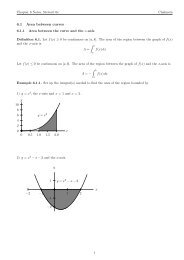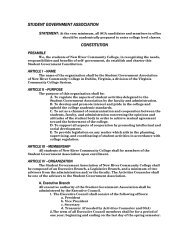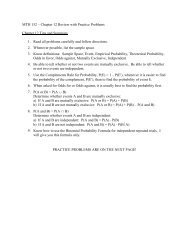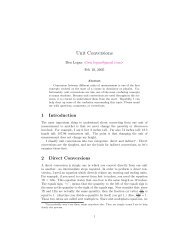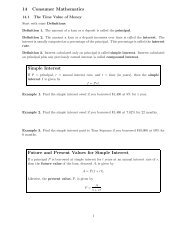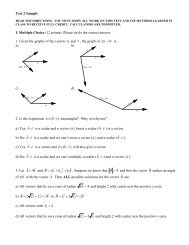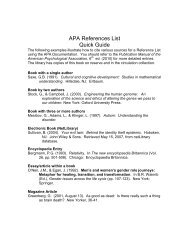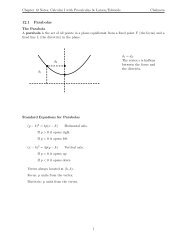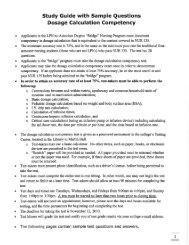Section 4.5: Implicit Differentiation Explicit Functions: Definition: An ...
Section 4.5: Implicit Differentiation Explicit Functions: Definition: An ...
Section 4.5: Implicit Differentiation Explicit Functions: Definition: An ...
You also want an ePaper? Increase the reach of your titles
YUMPU automatically turns print PDFs into web optimized ePapers that Google loves.
<strong>Section</strong> <strong>4.5</strong>: <strong>Implicit</strong> <strong>Differentiation</strong><strong>Explicit</strong> <strong>Functions</strong>:<strong>Definition</strong>: <strong>An</strong> explicit function is a function in which one variable is defined only in terms ofthe other variable.Examples:a) y = x 2 + 7Parabolab)c)yy2= 9 − xTop half of the circle centered at the origin with radius 3.2= − 9 − xBottom half of the circle centered at the origin with radius 3.<strong>Implicit</strong> <strong>Functions</strong>:<strong>Definition</strong>: <strong>An</strong> implicit function is a function in which one variable is not defined only in termsof another variable.a) y − x 2 = 7 Parabola2 2b) y + x = 9 Circle centered at the origin with radius 3.4 2 2 4 5c) y + 7 y x − y x − 9x= 3Some implicit functions can be written explicitly:• both examples (a) represent the same parabola and• (b) can be solved for either the top or the bottom of the circle.• (c) can not be solved explicitly for y in terms of x.<strong>Implicit</strong> <strong>Differentiation</strong>:We have seen how to differentiate functions of the form y = f (x). We also want to be able todifferentiate functions that either can’t be written explicitly in terms of x or the resulting functionis too complicated to deal with. To do this we use implicit differentiation.Key to implicit differentiation (chain rule):d[ ydxd[ xdx] = nyn n−1n] = nxdySteps to find of implicit functions involving the variables x and y.dx1. Treat y as a differentiable function of x.n−1dydxdxdx= nx2. Differentiate both sides of the equation with respect to x using all the rules we havedpreviously used. i.e. Apply the operator to every term and use the product, quotientdxand chain rules.n−1
dy3. Solve for as if it were a variable.dxa) Simplify each side of the equal sign.dy dyb) Bring all terms to one side of the equal sign and all non- terms to the other.dxdxdyc) Factor out . dxdyd) Divide to isolate . dxEx 1:dya) find for2 2y + x = 9 ;dxFirst take a derivative of every term:ddx2 d 2 d[ y ] + [ x ] = [] 9dxdxdy dxdy dx2 y + 2x= 0 Notice that at this step the nonzero terms have either ordx dxdx dxdxNow we let the terms = 1dxdy2 y + 2x(1)= 0dxdyNow solve for as if it were a variabledxdy 2x= −dx 2y
dyb) Find :2 3 3 3x y + y x = x ydxFirst take a derivative of every term:d 2 d 3 d 3 3[ x y] + [ y x] = [ x y ]dx dx dxWhen we take these derivatives we have to use the product rule in each case:ddxd 2 3 d d 3 3 d 3 3 d 3[ y] + y [ x ] + y [] x + x [ y ] = x [ y ] y [ x ]2x +x2dxdxdy dx 3 dx2 dy 3 2 dy 3+ y ⋅ 2x+ y + x ⋅ 3y= x ⋅ 3y+ y ⋅ 3xdx dx dx dx dxdxdxdx2dxdxNow we let the dxx2dx terms = 1dy32 dy 3 2 dy 3 2+ y ⋅ 2x+ y + x ⋅ 3y= x ⋅ 3y+ y ⋅ 3xdxdx dxNow solve for dxdy as if it were a variable.3x2dydxdydx+ x ⋅dydxdydx23 23 23y− x ⋅3y= y ⋅3x− y ⋅ 2x− y2 2 3 2 3 23( x + 3xy− 3xy ) = 3yx − 2yx− ydydx=33yx2− 2yx− y2 2 3 2( x + 3xy− 3xy )32 3Ex 2: Find the slope of the tangent line to the curve x − y = 0 at the point (1, 1)dyStep 1: Find because this is the slope of the tangent line.dxFirst take a derivative of every term:ddx2x2 d 3 d[ x ] − [ y ] = [] 0dxdxdx− 3y2dydx= 0dx
dx dyNow we let the terms = 1 and solve for as if it were a variable.dxdx2 x = 3y2x 2 =3y2dydxdydxdyStep 2: Evaluate at the point (1, 1) to get the slopedxdy 2(1) 2m = ( 1,1) = = dx23(1) 3Step 3: write the equation of the line:y − y= m( x − ) 11x2y −1 = ( x −1)32 1 y = x +3 3



